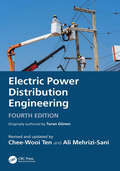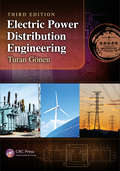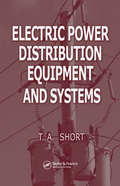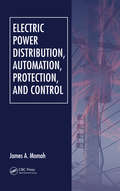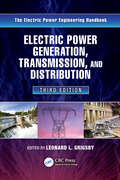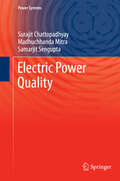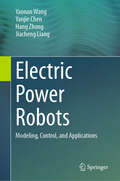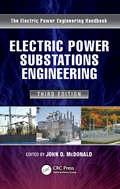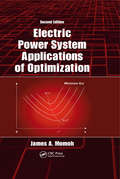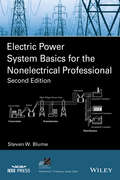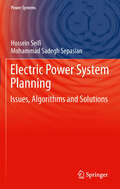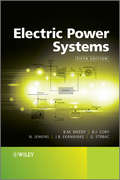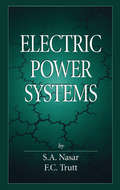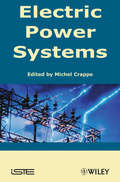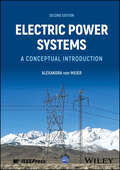- Table View
- List View
Electric Power Distribution Engineering
by Chee-Wooi Ten Ali Mehrizi-SaniAre you fascinated by the complex web of electrical power that illuminates our modern world? Do you want to understand the intricate systems responsible for delivering electricity to our homes, businesses, and industries? Look no further than Electric Power Distribution System Engineering, Fourth Edition by renowned author Turan Gönen, revised and updated by Chee-Wooi Ten and Ali Mehrizi-Sani. This captivating book takes you on a journey through the fascinating realm of electric power distribution, offering a comprehensive yet accessible exploration of the engineering principles, technologies, and practices that underpin this vital aspect of our daily lives. Whether you're a curious non-specialist, an avid reader with a thirst for knowledge, or a librarian or bookseller seeking an invaluable resource, Gönen's masterwork will both enlighten and captivate you.An early leader in the academic market, this book provides an overview of classical planning for electric power distribution systems, which has been used for many years in designing and analyzing electric power distribution systems. The authors have taken a bold initiative to update the content, incorporating relevant aspects reflecting the advancements of today's evolving smart grid. Within its pages, readers will discover detailed discussions on the principles of power distribution, including the fundamentals of power generation, transmission, and distribution. The authors provide detailed explanations of the various components and equipment used in distribution systems, such as transformers, circuit breakers, switches, and protective devices. As part of the book, planning for the distribution network involves sizing and considering candidate geographical locations/regions in relation to the capacity of existing infrastructure, allowing for new additions to be built. For example, this includes locations either extending another feeder from distribution substations or building new distribution substations, depending on what makes more sense. Many assumptions have been made for non-existing distribution feeders to calculate ballpark figures for determining voltage profile and power losses if they were to be constructed. Readers will gain insights into how these considerations translate into net positive, net negative, or net-zero loads. All of these aspects can be gradually integrated with renewable energy sources, innovative grid technologies, and distribution automation over time.The authors involved in this book have made significant contributions to the state-of-the-art development by incorporating recent updates from the literature, thereby addressing the latest advancements. One remarkable feature of Turan Gönen's Electric Power Distribution System Engineering is its strong focus on practical applications and real-world scenarios. In addition to providing theoretical knowledge, the book also offers numerous examples that effectively bridge the gap between theory and practice. This unique approach enables readers to comprehend the intricacies of distribution system engineering and apply their newfound knowledge to solve complex problems in the field. By seamlessly blending theoretical foundations with practical insights, Gonen's book emerges as an indispensable resource for aspiring engineers, professionals, and researchers, as it offers a comprehensive understanding of electric power distribution systems and their practical implications.
Electric Power Distribution Engineering
by Turan Gönen<p>A quick scan of any bookstore, library, or online bookseller will produce a multitude of books covering power systems. However, few, if any, are totally devoted to power distribution engineering, and none of them are true textbooks. Filling this vacuum in the power system engineering literature, Electric Power Distribution System Engineering broke new ground. <p>Designed specifically for junior- or senior-level electrical engineering courses, the book covers all aspects of distribution engineering from basic system planning and concepts through distribution system protection and reliability. Drawing on decades of experience to provide a text that is as attractive to students as it is useful to professors and practicing engineers, the author demonstrates how to design, analyze, and perform modern distribution system engineering. He takes special care to cover industry terms and symbols, providing a glossary and clearly defining each term when it is introduced. The discussion of distribution planning and design considerations goes beyond the usual analytical and qualitative analysis to emphasize the economical explication and overall impact of the distribution design considerations discussed.</p>
Electric Power Distribution Equipment and Systems
by Thomas Allen ShortPower distribution and quality remain the key challenges facing the electric utilities industry. Choosing the right equipment and architecture for a given application means the difference between success and failure. Comprising chapters carefully selected from the best-selling Electric Power Distribution Handbook, Electric Power Distribution Equipment and Systems provides an economical, sharply focused reference on the technologies and infrastructures that enable reliable, efficient distribution of power, from traversing vast distances to local power delivery.The book works inward from broad coverage of overall power systems all the way down to specific equipment application. It begins by laying a foundation in the fundamentals of distribution systems, explaining configurations, substations, loads, and differences between European and US systems. It also includes a look at the development of the field as well as future problems and challenges to overcome. Building on this groundwork, the author elaborates on both overhead and underground distribution networks, including the underlying concepts and practical issues associated with each. Probing deeper into the system, individual chapters explore transformers, voltage regulation, and capacitor application in detail, from basic principles to operational considerations.With clear explanations and detailed information, Electric Power Distribution Equipment and Systems gathers critical concepts, technologies, and applications into a single source that is ideally suited for immediate implementation.
Electric Power Distribution Handbook
by Thomas Allen ShortOf the "big three" components of electrical infrastructure, distribution typically gets the least attention. In fact, a thorough, up-to-date treatment of the subject hasn’t been published in years, yet deregulation and technical changes have increased the need for better information. Filling this void, the Electric Power Distribution Handbook delivers comprehensive, cutting-edge coverage of the electrical aspects of power distribution systems. The first few chapters of this pragmatic guidebook focus on equipment-oriented information and applications such as choosing transformer connections, sizing and placing capacitors, and setting regulators. The middle portion discusses reliability and power quality, while the end tackles lightning protection, grounding, and safety. The Second Edition of this CHOICE Award winner features: 1 new chapter on overhead line performance and 14 fully revised chapters incorporating updates from several EPRI projects New sections on voltage optimization, arc flash, and contact voltage Full-color illustrations throughout, plus fresh bibliographic references, tables, graphs, methods, and statistics Updates on conductor burndown, fault location, reliability programs, tree contacts, automation, and grounding and personnel protection Access to an author-maintained support website, distributionhandbook.com, with problems sets, resources, and online apps An unparalleled source of tips and solutions for improving performance, the Electric Power Distribution Handbook, Second Edition provides power and utility engineers with the technical information and practical tools they need to understand the applied science of distribution.
Electric Power Distribution Reliability (Power Engineering (Willis))
by Richard E. BrownDue to its high impact on the cost of electricity and its direct correlation with customer satisfaction, distribution reliability continues to be one of the most important topics in the electric power industry. Continuing in the unique tradition of the bestselling first edition, Electric Power Distribution Reliability, Second Edition consolidates all pertinent topics on electric power distribution into one comprehensive volume balancing theory, practical knowledge, and real world applications. Updated and expanded with new information on benchmarking, system hardening, underground conversion, and aging infrastructure, this timely reference enables you to— · Manage aging infrastructure · Harden electric power distribution systems · Avoid common benchmarking pitfalls · Apply effective risk management The electric power industry will continue to make distribution system reliability and customer-level reliability a top priority. Presenting a wealth of useful knowledge, Electric Power Distribution Reliability, Second Edition remains the only book that is completely dedicated to this important topic.
Electric Power Distribution, Automation, Protection, and Control
by James A. Momoh<p>New methods for automation and intelligent systems applications, new trends in telecommunications, and a recent focus on renewable energy are reshaping the educational landscape of today's power engineer. Providing a modern and practical vehicle to help students navigate this dynamic terrain, Electric Power Distribution, Automation, Protection, and Control infuses new directions in computation, automation, and control into classical topics in electric power distribution. <p>Ideal for a one-semester course for senior undergraduates or first-year graduate students, this text works systematically through basic distribution principles, renewable energy sources, computational tools and techniques, reliability, maintenance, distribution automation, and telecommunications. Numerous examples, problems, and case studies offer practical insight into the concepts and help build a working knowledge of protection schemes, fault analysis and synthesis, reliability analysis, intelligent automation systems, distribution management systems, and distribution system communications. The author details different renewable energy sources and teaches students how to evaluate them in terms of size, cost, and performance. <p>Guided firmly by the author's wealth of industrial and academic experience, your students will learn the tools and techniques used to design, build, and operate future generations of distribution systems with unparalleled efficiency, robustness, and sustainability.</p>
Electric Power Engineering Research and Education
by Vijay Vittal Elias Kyriakides Siddharth SuryanarayananThis unique volume covers the most compelling areas of advance in electric power engineering, from distributed generation and dispatch to power quality improvement and energy storage. The authors particularly highlight the seminal contributions of Dr. Gerald T. Heydt in the development and teaching of these technological advances, which have impacted the power industry and academia over the last 4 decades in areas such as transmission and distribution engineering, power engineering education, and centers for power engineering research.
Electric Power For Rural Growth: How Electricity Affects Rural Life In Developing Countries
by Douglas F. BarnesThis book offers important historical information on the state of rural electrification in the 1980s. It also summarizes the development of benefit evaluation methods, along with findings from recent research on the impact of rural electrification for development.
Electric Power Generation, Transmission, and Distribution (Electric Power Engineering Series)
by Leonard L. GrigsbyFeaturing contributions from worldwide leaders in the field, the carefully crafted Electric Power Generation, Transmission, and Distribution, Third Edition (part of the five-volume set, The Electric Power Engineering Handbook) provides convenient access to detailed information on a diverse array of power engineering topics. Updates to nearly every chapter keep this book at the forefront of developments in modern power systems, reflecting international standards, practices, and technologies. Topics covered include: Electric power generation: nonconventional methods Electric power generation: conventional methods Transmission system Distribution systems Electric power utilization Power quality L.L. Grigsby, a respected and accomplished authority in power engineering, and section editors Saifur Rahman, Rama Ramakumar, George Karady, Bill Kersting, Andrew Hanson, and Mark Halpin present substantially new and revised material, giving readers up-to-date information on core areas. These include advanced energy technologies, distributed utilities, load characterization and modeling, and power quality issues such as power system harmonics, voltage sags, and power quality monitoring. With six new and 16 fully revised chapters, the book supplies a high level of detail and, more importantly, a tutorial style of writing and use of photographs and graphics to help the reader understand the material. New chapters cover: Water Transmission Line Reliability Methods High Voltage Direct Current Transmission System Advanced Technology High-Temperature Conduction Distribution Short-Circuit Protection Linear Electric Motors A volume in the Electric Power Engineering Handbook, Third Edition. Other volumes in the set: K12648 Power Systems, Third Edition (ISBN: 9781439856338) K13917 Power System Stability and Control, Third Edition (ISBN: 9781439883204) K12650 Electric Power Substations Engineering, Third Edition (ISBN: 9781439856383) K12643 Electric Power Transformer Engineering, Third Edition (ISBN: 9781439856291)
Electric Power Grid Reliability Evaluation: Models and Methods
by Chanan Singh Panida Jirutitijaroen Joydeep MitraThe groundbreaking book that details the fundamentals of reliability modeling and evaluation and introduces new and future technologies Electric Power Grid Reliability Evaluation deals with the effective evaluation of the electric power grid and explores the role that this process plays in the planning and designing of the expansion of the power grid. The book is a guide to the theoretical approaches and processes that underpin the electric power grid and reviews the most current and emerging technologies designed to ensure reliability. The authors—noted experts in the field—also present the algorithms that have been developed for analyzing the soundness of the power grid. A comprehensive resource, the book covers probability theory, stochastic processes, and a frequency-based approach in order to provide a theoretical foundation for reliability analysis. Throughout the book, the concepts presented are explained with illustrative examples that connect with power systems. The authors cover generation adequacy methods, and multi-node analysis which includes both multi-area as well as composite power system reliable evaluation. This important book: • Provides a guide to the basic methods of reliability modeling and evaluation • Contains a helpful review of the background of power system reliability evaluation • Includes information on new technology sources that have the potential to create a more reliable power grid • Addresses renewable energy sources and shows how they affect power outages and blackouts that pose new challenges to the power grid system Written for engineering students and professionals, Electric Power Grid Reliability Evaluation is an essential book that explores the processes and algorithms for creating a sound and reliable power grid.
Electric Power Industry in Nontechnical Language
by Denise Warkentin-GlennIn the second edition of this bestseller, Denise Warkentin-Glenn presents in everyday language the nuances, history, and recent developments of the electric power industry. This new version includes updated information on utilities, merchant plants, rural cooperatives, government entities and more. It also has new chapters covering the 2005 Energy Policy Act, environmental standards, and updates to industry mergers and acquisitions. This important edition gives a comprehensive look at our country's most critical economic driver. Key Features: • Impacts of new regulation • Simple and clear explanations of generation, transmission and governance • How cleaner fuels and new technology are transforming the industry • The newest environmental standards
Electric Power Principles
by James L. KirtleyThis innovative approach to the fundamentals of electric power provides the most rigorous, comprehensive and modern treatment available. To impart a thorough grounding in electric power systems, it begins with an informative discussion on per-unit normalizations, symmetrical components and iterative load flow calculations.Covering important topics within the power system, such as protection and DC transmission, this book looks at both traditional power plants and those used for extracting sustainable energy from wind and sunlight.With classroom-tested material, this book also presents:the principles of electromechanical energy conversion and magnetic circuits; synchronous machines - the most important generators of electric power; power electronics; induction and direct current electric motors. Homework problems with varying levels of difficulty are included at the end of each chapter, and an online solutions manual for tutors is available. A useful Appendix contains a review of elementary network theory.For senior undergraduate and postgraduate students studying advanced electric power systems as well as engineers re-training in this area, this textbook will be an indispensable resource. It will also benefit engineers in electronic power systems, power electronic systems, electric motors and generators, robotics and mechatronics.www.wiley.com/go/kirtley_electric
Electric Power Quality
by Madhuchhanda Mitra Surajit Chattopadhyay Samarjit SenguptaIn the present day deregulated power market electric power quality issues have become great concerns of utilities, end users and manufacturers. Worldwide researches are going on to address those issues. Electric Power Quality has evolved from the researches carried out by the authors. The key features of the book can be highlighted as follows: the contents focuses, on one hand, different power quality issues, their sources and effects and different related standards, which are required for students, researchers and practising engineers and, on the other hand, measurement techniques for different power quality parameters, the content level is designed in such a way that the concepts of different power quality issues in modern power system are built up first, followed by some existing and new measurement methods. This content should attract the students, researchers and practising engineers, the predominant features are Lucid but concise description of the subject, detailed new measurement techniques and Electric Power Quality is intended for graduate, postgraduate and researchers as well as for professionals in the related fields. At the end, a chapter has been added which deals with a concept of generation of harmonics in a power system and its components.
Electric Power Robots: Modeling, Control, and Applications
by Yaonan Wang Yanjie Chen Hang Zhong Jiacheng LiangThis book introduces readers to power robot systems and their applications in the electric power industry. Specifically, the book delves into the research status, technological advancements, challenges encountered, and future potential applications of power operation robots across various stages of power systems. The book provides the latest technological advancements, including in-depth analysis of power operation robots, research directions, and key contributions. Understanding how these robots enhance the monitoring and maintenance efficiency of power systems, mitigate failure risks, and address the challenges of operation and maintenance in complex and large-scale networks is crucial. The topics covered in the book include mobile robot control, navigation, robotic arm control, inverse kinematics algorithms, image recognition, visual calibration, object grasping, and unmanned aerial robotic manipulation. The book is interwoven with practical application tasks typical of power industry, which are essential for mastering the design, application, and development trends of electric power robots. The content is easy to understand and rich in information. This book can serve as a reference for researchers specializing in power system automation, robotics, control theory, and artificial intelligence. For professionals working in power companies, robot manufacturers, system integrators, and related industries, this book offers practical guidance and solutions. For educators teaching courses in electrical engineering, robotics, automation control, and artificial intelligence, this book provides up-to-date knowledge and real-world examples to enhance classroom engagement and teaching quality. For undergraduate students majoring in electrical engineering, automation, robotics, and related fields, this book can serve as supplementary reading material to expand their knowledge base and ignite their passion for science and technology.
Electric Power Substations Engineering (Electrical Engineering Handbook)
by John D. McdonaldThe use of electric power substations in generation, transmission, and distribution remains one of the most challenging and exciting areas of electric power engineering. Recent technological developments have had a tremendous impact on all aspects of substation design and operation. With 80% of its chapters completely revised and two brand-new chapters on energy storage and Smart Grids, Electric Power Substations Engineering, Third Edition provides an extensive updated overview of substations, serving as a reference and guide for both industry and academia. Contributors have written each chapter with detailed design information for electric power engineering professionals and other engineering professionals (e.g., mechanical, civil) who want an overview or specific information on this challenging and important area. This book: Emphasizes the practical application of the technology Includes extensive use of graphics and photographs to visually convey the book’s concepts Provides applicable IEEE industry standards in each chapter Is written by industry experts who have an average of 25 to 30 years of industry experience Presents a new chapter addressing the key role of the substation in Smart Grids Editor John McDonald and this very impressive group of contributors cover all aspects of substations, from the initial concept through design, automation, and operation. The book’s chapters—which delve into physical and cyber-security, commissioning, and energy storage—are written as tutorials and provide references for further reading and study. As with the other volumes in the Electric Power Engineering Handbook series, this book supplies a high level of detail and, more importantly, a tutorial style of writing and use of photographs and graphics to help the reader understand the material. Several chapter authors are members of the IEEE Power & Energy Society (PES) Substations Committee and are the actual experts who are developing the standards that govern all aspects of substations. As a result, this book contains the most recent technological developments in industry practice and standards. Watch John D. McDonald talk about his book A volume in the Electric Power Engineering Handbook, Third Edition. Other volumes in the set: K12642 Electric Power Generation, Transmission, and Distribution, Third Edition (ISBN: 9781439856284) K12648 Power Systems, Third Edition (ISBN: 9781439856338) K13917 Power System Stability and Control, Third Edition (ISBN: 9781439883204) K12643 Electric Power Transformer Engineering, Third Edition (ISBN: 9781439856291)
Electric Power System Applications of Optimization (Second Edition)
by James A. Momoh<p>As the demand for energy continues to grow, optimization has risen to the forefront of power engineering research and development. Continuing in the bestselling tradition of the first edition, Electric Power System Applications of Optimization, Second Edition presents the theoretical background of optimization from a practical power system point of view, exploring advanced techniques, new directions, and continuous application problems. <p>The book provides both the analytical formulation of optimization and various algorithmic issues that arise in the application of various methods in power system planning and operation. The second edition adds new functions involving market programs, pricing, reliability, and advances in intelligent systems with implemented algorithms and illustrative examples. It describes recent developments in the field of Adaptive Critics Design and practical applications of approximate dynamic programming. To round out the coverage, the final chapter combines fundamental theories and theorems from functional optimization, optimal control, and dynamic programming to explain new Adaptive Dynamic Programming concepts and variants. <p>With its one-of-a-kind integration of cornerstone optimization principles with application examples, this second edition propels power engineers to new discoveries in providing optimal supplies of energy.</p>
Electric Power System Basics for the Nonelectrical Professional (2nd Edition)
by Steven W. BlumeThe second edition of Steven W. Blume's bestseller provides a comprehensive treatment of power technology for the non-electrical engineer working in the electric power industry This book aims to give non-electrical professionals a fundamental understanding of large interconnected electrical power systems, better known as the "Power Grid", with regard to terminology, electrical concepts, design considerations, construction practices, industry standards, control room operations for both normal and emergency conditions, maintenance, consumption, telecommunications and safety. The text begins with an overview of the terminology and basic electrical concepts commonly used in the industry then it examines the generation, transmission and distribution of power. Other topics discussed include energy management, conservation of electrical energy, consumption characteristics and regulatory aspects to help readers understand modern electric power systems. This second edition features: New sections on renewable energy, regulatory changes, new measures to improve system reliability, and smart technologies used in the power grid system Updated practical examples, photographs, drawing, and illustrations to help the reader gain a better understanding of the material "Optional supplementary reading" sections within most chapters to elaborate on certain concepts by providing additional detail or background Electric Power System Basics for the Nonelectrical Professional, Second Edition, gives business professionals in the industry and entry-level engineers a strong introduction to power technology in non-technical terms. Steve W. Blume is Founder of Applied Professional Training, Inc., APT Global, LLC, APT College, LLC and APT Corporate Training Services, LLC, USA. Steve is a registered professional engineer and certified NERC Reliability Coordinator with a Master's degree in Electrical Engineering specializing in power and a Bachelor's degree specializing in Telecommunications. He has more than 25 years' experience teaching electric power system basics to non-electrical professionals. Steve's engineering and operations experience includes generation, transmission, distribution, and electrical safety. He is an active senior member in IEEE and has published two books in power systems through IEEE and Wiley.
Electric Power System Basics for the Nonelectrical Professional (IEEE Press Series on Power and Energy Systems)
by Steven W. BlumeUnderstand the fundamentals of electrical power systems with this accessible guide Few subjects are more fundamental to modern life than electrical power. The systems that generate, transport, and distribute electricity are among the most essential contributors to modern industry, development, and everyday living. As energy demand grows and, with it, the electric power industry, more and more non-electrical professionals must make important policy and administrative decisions regarding the systems that power our world. Electric Power System Basics for the Nonelectrical Professional provides an education on the basics of this subject, including the various types of energy sources, types of transmission and distribution lines, grid modernization, and much more. From residential to industrial energy, and from metering principles to energy conservation techniques, this book provides a one-stop reference on all relevant areas of knowledge. Now fully updated to reflect the latest advances and the current state of a growing industry, it is a must-own for anyone looking to bring foundational power systems knowledge to bear on policy or industrial issues. Readers of the third edition will also find: Coverage of wildfire mitigation strategies to reduce safety riskDetailed discussion of regulatory changes and their effects on system operationsUpdated coverage of system reliability and smart technologiesUpdated discussion of the transitioning digital power grid Electric Power System Basics for the Nonelectrical Professional is ideal for power industry executives and state regulators.
Electric Power System Planning
by Hossein Seifi Mohammad Sadegh SepasianThe present book addresses various power system planning issues for professionals as well as senior level and postgraduate students. Its emphasis is on long-term issues, although much of the ideas may be used for short and mid-term cases, with some modifications. Back-up materials are provided in twelve appendices of the book. The readers can use the numerous examples presented within the chapters and problems at the end of the chapters, to make sure that the materials are adequately followed up. Based on what Matlab provides as a powerful package for students and professional, some of the examples and the problems are solved in using M-files especially developed and attached for this purpose. This adds a unique feature to the book for in-depth understanding of the materials, sometimes, difficult to apprehend mathematically. Chapter 1 provides an introduction to Power System Planning (PSP) issues and basic principles. As most of PSP problems are modeled as optimization problems, optimization techniques are covered in some details in Chapter 2. Moreover, PSP decision makings are based on both technical and economic considerations, so economic principles are briefly reviewed in Chapter 3. As a basic requirement of PSP studies, the load has to be known. Therefore, load forecasting is presented in Chapter 4. Single bus Generation Expansion Planning (GEP) problem is described in Chapter 5. This study is performed using WASP-IV, developed by International Atomic Energy Agency. The study ignores the grid structure. A Multi-bus GEP problem is discussed in Chapter 6 in which the transmission effects are, somehow, accounted for. The results of single bus GEP is used as an input to this problem. SEP problem is fully presented in Chapter 7. Chapter 8 devotes to Network Expansion Planning (NEP) problem, in which the network is planned. The results of NEP, somehow, fixes the network structure. Some practical considerations and improvements such as multi-voltage cases are discussed in Chapter 9. As NEP study is typically based on some simplifying assumptions and Direct Current Load Flow (DCLF) analysis, detailed Reactive Power Planning (RPP) study is finally presented in Chapter 10, to guarantee acceptable ACLF performance during normal as well as contingency conditions. This, somehow, concludes the basic PSP problem. The changing environments due to power system restructuring dictate some uncertainties on PSP issues. It is shown in Chapter 11 that how these uncertainties can be accounted for. Although is intended to be a text book, PSP is a research oriented topic, too. That is why Chapter 12 is devoted to research trends in PSP. The chapters conclude with a comprehensive example in Chapter 13, showing the step-by-step solution of a practical case.
Electric Power Systems
by N. Jenkins B. J. Cory B. M. Weedy G. Strbac J. B. EkanayakeThe definitive textbook for Power Systems students, providing a grounding in essential power system theory while also focusing on practical power engineering applications.Electric Power Systems has been an essential book in power systems engineering for over thirty years. Bringing the content firmly up-to-date whilst still retaining the flavour of Weedy's extremely popular original, this Fifth Edition has been revised by experts Nick Jenkins, Janaka Ekanayake and Goran Strbac. This wide-ranging text still covers all of the fundamental power systems subjects but is now expanded to cover increasingly important topics like climate change and renewable power generation. Updated material includes an analysis of today's markets and an examination of the current economic state of power generation. The physical limits of power systems equipment - currently being tested by the huge demand for power - is explored, and greater attention is paid to power electronics, voltage source and power system components, amongst a host of other updates and revisions.Supplies an updated chapter on power system economics and management issues and extended coverage of power system components. Also expanded information on power electronics and voltage source, including VSC HVDC and FACTS. Updated to take into account the challenges posed by different world markets, and pays greater attention to up-to-date renewable power generation methods such as wind power. Includes modernized presentation and greater use of examples to appeal to today's students, also retains the end of chapter questions to assist with the learning process. Also shows students how to apply calculation techniques.
Electric Power Systems
by Syed A. Nasar F. C TruttThe field of electrical engineering has become increasingly diversified, resulting in a spectrum of emerging topics - from microelectromechanics to light-wave technology. Keeping pace with progressing technology, and covering the scope of related subjects, Electric Power Systems provides introductory, fundamental knowledge in several areas. The tex
Electric Power Systems (Wiley-iste Ser.)
by Michel CrappeThe creation of a European liberalized electricity internal market and EU commitments for the reduction of greenhouse gas emissions (Kyoto Protocol) and for the use of renewable energy generation technologies induce new important constraints and problems on the electric power systems in Europe. This then creates the need for more research and development to engage with these new challenges in order to preserve the reliability of these systems. This book aims to provide advanced tools, covering major aspects, for people involved with such research and development. Split into two parts (the first covering the operation and control of electric power systems and the second the stability and defence of electric power systems), this book gathers together contributions from numerous well-known European specialists in academia and the electrical industry and will be an illuminating read for those involved in this field or who have some knowledge of the fundamental notions.
Electric Power Systems for Non-Electrical Engineers
by Anup Kumar TripathiThis book explains the electrical power systems for non-electrical engineers and includes topics like electrical energy systems, electrical power systems structure, single-phase AC circuit fundamentals and three-phase systems, power system modeling, power system representation, power system operation, power flow analysis, economic operation of power systems, power system fault analysis, power system protection fundamentals, and so forth. Examples have been provided to clarify the description, and review questions are provided at the end of each chapter.Features: Provides a simplified description of fundamentals of electrical energy systems and structure of electrical power systems for non-electrical engineers. Gives a detailed description of AC circuit fundamentals and three-phase systems. Describes power system modeling and power system representation. Covers power system operation, power flow analysis, and fundamentals of economic operation of power systems. Discusses power system fault analysis and fundamentals of power system protection with examples, and also includes renewable energy systems. This book has been aimed at senior undergraduate and graduate students of non-electrical engineering background.
Electric Power Systems: A Conceptual Introduction (Wiley Survival Guides In Engineering And Science Ser. #8)
by Alexandra von MeierDiscover the technology for producing and delivering electricity in this easily accessible introduction to power systems Electric Power Systems underlie virtually every aspect of modern life. In the face of an unprecedented transition from fossil fuels to clean energy, it has never been more essential for engineers and other professionals from diverse disciplines to understand the electric grid and help chart its future. Since its original publication, Electric Power Systems has served as a uniquely accessible and qualitative introduction to the subject, offering a foundational overview with an emphasis on key concepts and building physical intuition. Now revised and updated to bring even greater rigor and incorporate the latest technologies, it remains an indispensable introduction to this vital subject. Readers of the revised and expanded second edition of Electric Power Systems will also find: End-of-chapter problems to facilitate and reinforce learning New discussions of subjects including load frequency control, protection, voltage stability, and many others More quantitative treatment of topics such as voltage regulation, power flow analysis, generator and transformer modeling with numerical examples Entirely new chapters on generation and storage resources, power electronics, and the analysis of transmission lines Electric Power Systems is an ideal textbook for graduate and advanced undergraduate students in engineering, as well as for a broad range of professionals, such as computer and data scientists, solar and wind energy manufacturers and installers, energy storage providers, economists, policy makers, legal and regulatory staff, and advocacy organizations.
Electric Power Systems: Advanced Forecasting Techniques and Optimal Generation Scheduling
by João P. S. CatalãoElectric Power Systems: Advanced Forecasting Techniques and Optimal Generation Scheduling helps readers develop their skills in modeling, simulating, and optimizing electric power systems. Carefully balancing theory and practice, it presents novel, cutting-edge developments in forecasting and scheduling. The focus is on understanding and solving pivotal problems in the management of electric power generation systems. Methods for Coping with Uncertainty and Risk in Electric Power Generation Outlining real-world problems, the book begins with an overview of electric power generation systems. Since the ability to cope with uncertainty and risk is crucial for power generating companies, the second part of the book examines the latest methods and models for self-scheduling, load forecasting, short-term electricity price forecasting, and wind power forecasting. Toward Optimal Coordination between Hydro, Thermal, and Wind Power Using case studies, the third part of the book investigates how to achieve the most favorable use of available energy sources. Chapters in this section discuss price-based scheduling for generating companies, optimal scheduling of a hydro producer, hydro-thermal coordination, unit commitment with wind generators, and optimal optimization of multigeneration systems. Written in a pedagogical style that will appeal to graduate students, the book also expands on research results that are useful for engineers and researchers. It presents the latest techniques in increasingly important areas of power system operations and planning.
